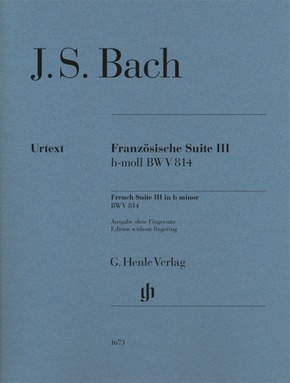Johann Sebastian Bach - Französische Suite III h-moll BWV 814 - Besetzung: Klavier zu zwei Händen
| Verlag | Henle |
| Auflage | 2022 |
| Seiten | 15 |
| Format | 17,2 x 0,2 x 31,1 cm |
| Gewicht | 103 g |
| Reihe | G. Henle Urtext-Ausgabe |
| ISBN-13 | 9790201816739 |
| Bestell-Nr | 95541163BA |
Bachs Französische Suiten zählen zu seinen beliebtesten Klavierwerken und werden auch sehr gerne im Unterricht eingesetzt. Dies war schon zur Zeit ihrer Entstehung der Fall, so dass wir heute eine kaum überschaubare Zahl an Abschriften aus Bachs Schülerkreis kennen, die viele vermutlich authentische Varianten überliefern. Der Herausgeber Ullrich Scheideler stellt die komplizierte Quellenlage in dieser revidierten Henle-Urtextausgabe in mustergültiger Klarheit dar.
Die Suite III h-moll BWV 814 ist dem Gesamtband HN 1593 entnommen und eignet sich als handliche und günstige Einzelausgabe vorzüglich für den Unterricht. Dazu trägt auch der Umgang mit den Ornamenten bei: Aus den Abschriften werden zusätzliche Zeichen in den Notentext übernommen und das Vorwort erläutert die Ausführung, so dass diese Urtextausgabe zugleich eine ausgezeichnete Einführung in die barocke Verzierungspraxis bietet. Ein weiterer Pluspunkt der Ausgabe: Interessante Abweichungen der verschiedenen Quellen sind leicht zugänglich in Fußnoten wiedergegeben, im Anhang enthält sie das alternative Trio BWV 814a, das in mehreren Abschriften überliefert ist. Summa summarum: Ein idealer Einstieg in die Bach'sche Suitenwelt!
Inhaltsverzeichnis:
Französische Suite h-moll BWV 814
Bach's French Suites are among his most popular keyboard works, and are also much used as teaching material. This was already the case at the time of their composition, so that today a vast number of copies survives from Bach's own circle of students. These copies provide many, presumably authentic, variants. In this revised Henle Urtext, editor Ullrich Scheideler presents the complicated source situation with exemplary clarity.
Suite no. III in b minor, BWV 814, is extracted from the complete volume HN 1593, and as a handy and reasonably-priced single edition is perfectly suited for teaching. This aspect is supplemented by the information provided on ornamentation: additional ornamentation signs from the copies have been transferred to our musical text, and the Preface explains their execution, making this Urtext edition an excellent introduction to Baroque ornamentation practice too. As a further plus point, interesting differences between the sources are easily accessible i n footnotes, while the Appendix contains the alternative Trio BWV 814a, which survives in several copies. In summary: an ideal entry-point into the world of Bach's Suites!

